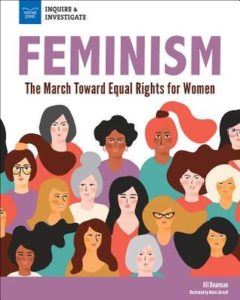“Feminism: Finding Our Way Forward”
Do you think men and women are equal? Do you think women around the world enjoy the same rights and privileges as men? What about jobs—can men and women work the same jobs and get paid the same for their work?
Many people believe that all people should be treated equally, whether they’re male, female, or gender nonconforming. But the way our world works doesn’t always reflect this ideal of equality. Women are often treated differently from men. Even today, in the United States, women statistically earn less than men working the same jobs. You’ll find few women heading up large corporations. And women are more likely than men to live in poverty.
This can be a distressing topic to discuss in classrooms! It’s hard for people of any age to learn that their gender might be unfairly counted against them, but perhaps especially for girls in their teens, who are dealing with a slew of messages from society about how women look and behave. However, it’s an important subject to talk about. Only by recognizing what has improved and what needs work can future generations develop their own goals and plans and continue the process of addressing the inequality they see in the world.
An important part of this process is learning the history of feminism. Who was Alice Paul and what did she do for women? How did Queen Elizabeth maintain her power? Why was abolitionism such an important step for feminism in the United States? What is intersectionality and what does it have to do with all women?
As kids start to dive into questions like these and confront their own expectations, biases, and assumptions, they can begin to develop goals and pinpoint ways they can be part of making gender equality a reality for all people. It’s an exciting step!
In Feminism: The March Toward Equal Rights for Women, young people get the chance to explore the history of those who came before and imagine the future of those who continue the work. There is still a long way to go before women are considered equal around the world, but the journey is a necessary one that can be fully experienced by those paying attention.
Here are some ideas to get kids to pay attention to the ongoing work for equal rights for all genders!
Share Your Concerns
How is the world different for those of different genders? What are some of the different experiences, reactions, and ideas that different genders have?
In this activity, you’ll share your thoughts in a safe space with people who aren’t the same gender as you.
Ask a group of classmates or friends to finish this sentence according to their own gender: “Having my gender identity means . . . .” Have everyone write down one or two responses on individual sticky notes.
On a whiteboard, put the sticky notes in groups according to gender identity. In those groups, put the sticky notes in positive and negative sections. For example, someone might write, “Being female means getting to wear skirts when it’s hot” or “Being male means not letting yourself cry.”
As a group, discuss the idea on each sticky note. Consider these questions.
- Can a male, female, or nonconforming gender do this?
- Why or why not?
- Do people of all genders want to do this?
- What’s preventing them?
- Has this action been open to other genders in the past?
- What changed?
- How can society support the needs and wishes of all genders?
To investigate more, do some research and find examples of times in history when a woman protested a law that kept her from doing something she wanted to do. For example, women have been barred from working certain jobs and holding office. How did they work to change those laws? How long did it take? How did changing one law change the world for many people?
Write Your Politician
Suffragists did a lot of letter writing as they fought for women’s right to vote. This was before email and social media, so their letters were written on paper and sent by mail. In today’s world, politicians receive lots of communications about different causes that people feel strongly about. Add your voice!
Choose a topic that you feel strongly about. This can be climate change, immigration, war, human rights, or something else.
At the library or on the internet, do some research on your chosen topic. Who are the major players with the power to effect change? What are their views on the topic? Do different people have different viewpoints?
Choose one person who agrees with your views and another person who has the opposite views. Write each of them a letter explaining your position. What can you write to get them to agree with you? How can you show your support for the person whose values align with yours?
Read the letters aloud to a friend or classmate. See if they can guess who it is you’re writing to. Do they think your letters were convincing?
To investigate more, imagine how one or more of the historical figures from this chapter would collaborate with a feminist, real or imagined, of today? What would feminists past and present focus on together in the twenty-first century?
More classroom resources can be found at https://nomadpress.net/wordpress/wp-content/uploads/2018/07/Feminism-Classroom-Guide.pdf.
Feminism: The March Toward Equal Rights for Women
Author: Jill Dearman
Illustrator: Alexis Cornell
Published April 9th, 2019 by Nomad Press
About the Book: Why are women treated differently from men? What is feminism? Why is this movement such an important part of the history of civic rights, and why is it still important today?
Feminism: The March Toward Equal Rights for Women invites middle and high schoolers to examine the different stages of the feminist movement, from early mentions in history through the suffragettes’ fight for the vote to today’s evidence of feminism in the struggle for equal pay and equal rights around the world. As social justice movements gain more traction in the national news media, many students are evolving into activist citizens who are working towards bettering humanity and the planet. This history of feminism gives them an introduction to the ways and means of community activism, which can be applied to a multitude of causes.
Feminism: The March Toward Equal Rights for Women introduces readers to some of the icons of feminism, including Simone De Bouvier, Gloria Steinem, and Angela Davis. By examining and deconstructing writings and other arts, readers gain a deeper understanding of the struggles women and men have undertaken for the deceptively simple goal of equal rights for all. Issues such as domestic violence and the fight for equal pay for equal work, plus a discussion of the more recent #metoo movement, all encourage kids to pay close attention to the world in which we live and insist on justice at every turn.
Feminism includes critical-thinking activities and research exercises to encourage readers to dive deep into the topic and consider viewpoints from many different identities. Fun facts, links to online primary sources and other supplemental material, and essential questions take readers on an exploration of the past, present, and future of feminism.
Feminism is part of a set of four books called Inquire & Investigate Social Issues of the Twenty-First Century, which explores the social challenges that have faced our world in the past and that continue to drive us to do better in the future. Other titles in this set are Gender Identity, Immigration Nation, and Race Relations.
Nomad Press books integrate content with participation, encouraging readers to engage in student-directed learning as opposed to teacher-guided instruction. This student-centered approach provides readers with the tools they need to become inquiry-based learners. Common Core State Standards and National Curriculum Standards for Social Studies all place project-based learning as key building blocks in education. Combining content with inquiry-based projects stimulates learning and makes it active and alive. As informational texts, our books provide key ideas and details from which readers can make their own inferences. Nomad’s unique approach simultaneously grounds kids in factual knowledge while allowing them the space to be curious, creative, and critical thinkers.
About the Author: Jill Dearman earned an MFA from the New School and is an award-winning author of several books, including The Great Bravura (She Writes Press, 2015). She teaches writing at NYU’s College of Applied Liberal Arts and at The College of New Rochelle, Rosa Parks Campus, and also serves as a private editing and writing coach. She lives in New York City.
Thank you so much for this guest post looking at how equal rights for women is still very much a timely topic!



I actually had an 8th grade boy who was surprised that feminism basically meant equal rights for women. He thought that it meant women hated men. Made me wonder about what he was learning at home. Definitely room for some conversation. I love it when our male teachers tell students THEY are feminists. Again, sometimes takes more explanation than it should!